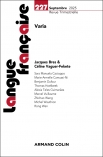
Langages n° 175 (3/2009)
Pour acheter ce numéro, contactez-nous
Recevez les numéros de l'année en cours et accédez à l'intégralité des articles en ligne.
In the Germanic languages, verbs of manner of movement can regularly be used in construction with a directional prepositional phrase in order to denote a telic movement event (e.g. The hunters walked into the forest). We show that the Romance languages, allow such a construction, too, but only with a limited group of verbs (e.g. the verbs for slide or jump) but not for the verbs corresponding to float or march, for instance. The syntactic limitations observed with the latter verbs have given rise to the idea of a “lexicalisation parameter" (Talmy 1985), while the former group has rather been dismissed as idiosyncratic lexical exceptions from this general pattern. In this paper, we develop the hypothesis that there is in fact a parameter in the area of semantic composition that distinguishes movement verb constructions in e.g. French and German. It is proposed that in Romance, a telic construction with a PP can only be based on manner of movement verbs whose lexical meaning makes reference to a homomorphic mapping between manner and progression on the path. It is shown that such a regularity falls out naturally from the theory of telicity in Rothstein (2004). The paper moreover addresses a very curious observation in the area of manner of movement verbs : in the Germanic languages, the verb climb can be combined with different directions (climb up or climb down) while in Romance (specifically, French), only upward direction is possible. This effect is argued to be another regular consequence of the same proposed parameter.

